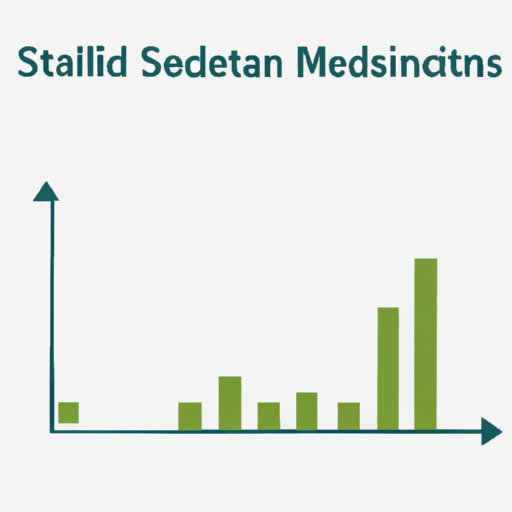
Introduction
Have you ever wondered what the middle value in a dataset is? How do you find it, and why is it important? The answer to both questions is the median, one of the most fundamental measures of central tendency in statistics. In this article, we will provide you with a comprehensive guide to finding the median in a dataset, regardless of its size or complexity. We will include step-by-step instructions, useful tips and tricks, common errors to avoid, and real-life examples that illustrate the significance of the median in data analysis.
Eight Simple Steps to Finding the Median in a Dataset
The first step to finding the median is to sort the dataset in ascending or descending order, depending on your preference. Once you have done that, follow these steps:
- Count the total number of values in the dataset;
- If the number of values is odd, find the middle value by dividing the total number of values by 2 and rounding up to the nearest whole number;
- If the number of values is even, find the two middle values by dividing the total number of values by 2, and then taking the average of the two values;
- The resulting value(s) is the median of the dataset;
- If the dataset has extreme values or outliers, use a box plot or another visualization tool to detect them;
- Decide whether to include or exclude the extreme values in the calculation of the median, depending on the purpose of the analysis;
- Check your calculation by comparing the result with the value(s) obtained from built-in functions or statistical software;
- If you encounter errors or inconsistencies, recheck your steps and make sure you have not skipped any values or counted them twice.
By following these simple steps, you can find the median of any dataset, even with missing or incomplete values. However, keep in mind some common errors that may affect your results, such as rounding errors, data entry errors, or inconsistent sorting. If you encounter any of these issues, go back to the dataset and double-check your calculations before proceeding.
The Ultimate Guide to Finding the Median: Tips and Tricks
Once you have mastered the basic steps of finding the median, you may encounter more complex scenarios that require advanced strategies and techniques. Here are some tips and tricks to help you deal with such situations:
- For datasets with many repeated values, use the formula n/2 + 1, where n is the total number of values, to find the median;
- For datasets with missing or incomplete values, use the mean or mode instead of the median, or consider removing the outliers;
- For datasets with skewed distributions, use the median instead of the mean or mode, as it represents the central tendency better;
- For datasets with exponential or logarithmic scales, use the geometric or harmonic mean instead of the arithmetic mean or median;
- Use built-in functions and statistical software to find the median automatically and reduce human errors or biases;
- Double-check your results and assumptions by using visual aids, such as histograms or scatter plots, to confirm the central tendency and variability of the dataset;
- Follow the principle of parsimony: choose the simplest measure of central tendency that best represents your data, and avoid overfitting or underfitting the model;
- Consult with experts or reference books to learn more about advanced statistical measures and their applications.
By applying these tips and tricks, you can become an expert in finding the median in any dataset, no matter how complex or ambiguous it may seem. The more you practice and refine this skill, the more confidence and accuracy you will have in your data analysis.

A Visual Guide to Finding the Median in Statistics
To help you visualize the process of finding the median, we have created some infographics and diagrams that illustrate the steps and the results. Here are some examples:
- A histogram that displays the frequency distribution of the dataset, with the median marked by a vertical line;
- A box plot that shows the quartiles, range, and outliers of the dataset, with the median represented by the central line;
- A scatter plot that compares the median to other statistical measures, such as the mean and mode, and shows their relationships;
- A pie chart that visualizes the relative proportions of the dataset, and highlights the median as the dividing line between the two halves;
- A line graph that plots the changes in the median over time, and reveals any trends or patterns.
By using these visual aids, you can simplify the process of finding the median, and also compare it to other measures of central tendency for a more comprehensive view of the dataset. However, keep in mind that different visualization tools may lead to different results or interpretations, depending on the context and the purpose of the analysis. Therefore, use them wisely and cautiously, and cross-check with other sources of information.
Tips for Beginners: How to Find the Median in a Dataset
If you are a beginner in statistics or data analysis, you may find the concept of median confusing or intimidating. Here are some tips and exercises that can help you practice and understand the basics:
- Read reference books or online tutorials that explain the concept of central tendency and its different measures, including the median, mean, and mode;
- Collect some simple datasets from real-life situations, such as the prices of goods in a store or the scores of a quiz, and calculate the median using the eight steps described above;
- Create some hypothetical datasets with different characteristics, such as symmetric, skewed, or bimodal distributions, and compare the results of the median to other measures of central tendency;
- Use built-in functions or statistical software to calculate the median automatically, and compare the results to your manual calculations;
- Practice interpreting the median in the context of real-life scenarios, such as income distribution, education levels, or health outcomes, and identify the implications and limitations of the measure.
By following these simple exercises, you can quickly gain confidence and familiarity with the concept and calculation of the median, and also appreciate its relevance and usefulness in data analysis.
The Importance of the Median in Statistics: A Step-by-Step Guide
The median is not just a simple measure of central tendency, but also a powerful tool for investigating the characteristics and relationships of datasets. Here are some steps to help you understand the statistical significance of the median:
- Compare the median to other measures of central tendency, such as the mean or mode, to identify the strengths and weaknesses of each measure;
- Use the median to describe the spread or variability of the dataset, by calculating the interquartile range, the range, or the standard deviation;
- Explore the relationship between the median and other variables or factors, by plotting the median against time, location, demographics, or other variables;
- Compare the medians of different datasets or subgroups, to identify differences or similarities in their characteristics or trends;
- Use the median as a benchmark or reference point for decision-making, policy evaluation, or performance assessment, by comparing it to the relevant benchmarks or standards;
- Visualize the median and its distribution using different techniques, such as density plots, kernel density estimates, or heatmaps, to gain a deeper understanding of the dataset and its patterns.
By applying these steps, you can make the most of the median in your data analysis, and also uncover new insights and opportunities for research or innovation.
Median vs. Mean: Understanding the Difference and How to Find Them
Although the median and mean are both measures of central tendency, they are not interchangeable, and each has its own strengths and limitations. Here are some differences between the median and mean, and how to find them:
- The median is the middle value of the dataset, while the mean is the sum of all values divided by the total number of values;
- The median is less affected by extreme or outlier values, while the mean is more sensitive to such values;
- The median is more appropriate for skewed or asymmetric distributions, while the mean is more appropriate for symmetric distributions;
- To find the mean, add all values and divide by the total number of values. For example, the mean of the dataset {1,3,5,7,9} is (1+3+5+7+9)/5 = 5;
- To find the median, sort the dataset in ascending or descending order and find the middle value(s). For example, the median of the dataset {1,3,5,7,9} is 5;
- Use the median or mean depending on the purpose and context of the analysis, and also consider using other measures of central tendency, such as the mode or geometric mean, when appropriate.
By understanding the difference between the median and mean, you can choose the most appropriate measure for your dataset, and avoid misleading or erroneous conclusions.
Efficient Ways to Find the Median in Large Datasets
For large datasets, finding the median can be a time-consuming and complex task, especially when the dataset has millions or billions of records. Here are some efficient ways to find the median in large datasets:
- Use algorithms or libraries that are optimized for finding the median in large datasets, such as Quickselect, Heaps, or B-Trees;
- Sample a subset of the dataset that is representative of the whole dataset, and find the median of the subset;
- Divide the dataset into smaller parts or clusters, and find the median of each part, then calculate the median of the medians;
- Parallelize the calculation of the median across multiple CPUs or nodes, using distributed computing frameworks, such as Hadoop or Spark;
- Use approximations or estimations of the median, such as the median of medians, or the weighted median, to reduce the computation time and memory usage;
- Visualize the dataset using techniques that highlight the distribution and patterns of the data, such as heatmaps or scatter plots, and combine them with statistical summaries, such as percentiles or quartiles, to estimate the median.
By using these efficient ways, you can find the median in large datasets with minimal effort and time, and also scale up the analysis to handle even larger datasets in the future.
Conclusion
In this article, we have provided you with a comprehensive guide to finding the median in a dataset, from the basic eight steps to the advanced tips and tricks, and the real-life examples and visual aids. We hope that this guide has helped you improve your skills and knowledge in statistics and data analysis, and also inspired you to explore further the possibilities of finding central tendency measures beyond the median. Remember to practice, verify, and consult, and also enjoy the process of discovering the hidden insights and stories behind your data.




